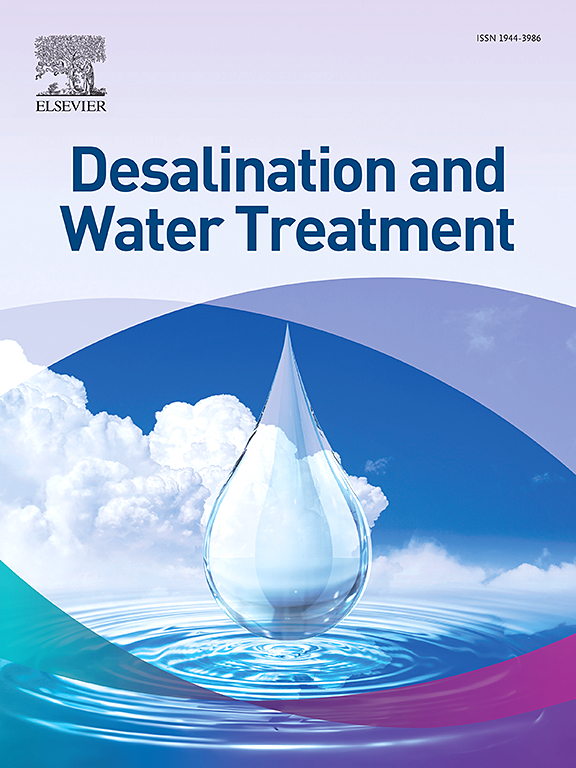香蕉花吸附亚甲基蓝染料的动力学、平衡、热力学和传质研究
IF 1
4区 工程技术
Q4 ENGINEERING, CHEMICAL
引用次数: 0
摘要
由于染料难以降解,因此从废水中去除颜色仍然是工业面临的最具挑战性的要求之一,这些染料因此无法逃脱传统的废水处理工艺并持续存在于环境中。本研究旨在评价和优化新型生物吸附剂香蕉小花对染料的吸附性能。通过批量实验考察了粒径、pH、搅拌、温度、初始浓度和吸附剂用量对吸附效果的影响。对动力学和平衡数据进行了建模,并进行了传质研究以阐明生物吸附的机理。平衡数据用Sips和Langmuir等温线模型模拟效果最好。在最佳pH为6.0、生物吸附剂剂量为1.0 mg·L -1、温度为300 K的条件下,最大吸附量为219 mg·g -1。动力学数据最好用伪二阶模型表示。主要的输运机制是颗粒内扩散,而主要的附着机制是物理吸附。采用田口法,结合方差分析,确定了香蕉小花对亚甲基蓝生物吸附的最佳操作参数水平。结果表明,吸附量和去除率最高的参数组分别为A3-B1-C3(初始浓度= 200 mg·L - 1,生物吸附剂剂量= 500 mg·L - 1,接触时间= 60 min)和A1-B3-C3(初始浓度= 50 mg·L - 1,生物弯曲剂量= 2000 mg·L - 1,接触时间= 20 min)。其中,初始浓度对生物吸附能力的影响最为显著,而吸附剂剂量对去除率的影响最为显著。成功地建立并验证了基于二次方程的综合因素相互作用的预测模型。本文章由计算机程序翻译,如有差异,请以英文原文为准。
Biosorption of methylene blue dye using banana floret:: kinetic, equilibrium, thermodynamic and mass transfer studies
Colour removal from effluents remains one of the most challenging requirements faced by indus - tries due to the difficulty of degrading dyes which consequently escape conventional wastewater treatment processes and persist in the environment. This study aimed to assess and optimise the dye adsorption performance of banana floret, a novel biosorbent. Batch experiments were con - ducted to assess the effects of particle size, pH, agitation, temperature, initial concentration and sorbent dose. Kinetic and equilibrium data were modelled, and mass transfer studies were con - ducted to elucidate the mechanisms of biosorption. Equilibrium data were best simulated using the Sips and Langmuir isotherm models. At an optimum pH of 6.0, biosorbent dose of 1.0 mg·L –1 and temperature of 300 K, a maximum sorption capacity of 219 mg·g –1 was observed. The kinetic data were best represented by the pseudo-second-order model. The dominant transport mechanism was attributed to intraparticle diffusion, while the dominant attachment mechanism was phys - ical sorption. The Taguchi method, in combination with analysis of variance, was used to deter - mine the optimum levels of operational parameters for maximising the biosorption of methylene blue by banana floret. The parameter group which produced the highest biosorption capacity and percent removal was determined to be A3-B1-C3 (initial concentration = 200 mg·L –1 , biosorbent dose = 500 mg·L –1 , contact time = 60 min) and A1-B3-C3 (initial concentration = 50 mg·L –1 , biosor - bent dose = 2000 mg·L –1 , contact time = 20 min), respectively. Among these parameters, the initial concentration had the most significant effect on the biosorption capacity, while sorbent dose was most significant on percent removal. A predictive model based on a quadratic equation which incorporates the factor interactions was successfully developed and validated.
求助全文
通过发布文献求助,成功后即可免费获取论文全文。
去求助
来源期刊

Desalination and Water Treatment
工程技术-工程:化工
CiteScore
2.20
自引率
9.10%
发文量
0
审稿时长
5.3 months
期刊介绍:
The journal is dedicated to research and application of desalination technology, environment and energy considerations, integrated water management, water reuse, wastewater and related topics.
 求助内容:
求助内容: 应助结果提醒方式:
应助结果提醒方式:


